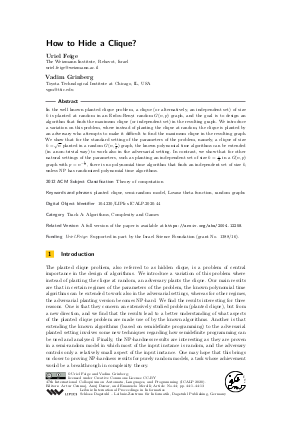How to Hide a Clique?
Authors Uriel Feige, Vadim Grinberg
-
Part of:
Volume:
47th International Colloquium on Automata, Languages, and Programming (ICALP 2020)
Part of: Series: Leibniz International Proceedings in Informatics (LIPIcs)
Part of: Conference: International Colloquium on Automata, Languages, and Programming (ICALP) - License:
 Creative Commons Attribution 3.0 Unported license
Creative Commons Attribution 3.0 Unported license
- Publication Date: 2020-06-29
File

PDF
LIPIcs.ICALP.2020.44.pdf
- Filesize: 456 kB
- 13 pages
Document Identifiers
Related Versions
-
A full version of the paper is available at https://arxiv.org/abs/2004.12258.
Subject Classification
ACM Subject Classification
- Theory of computation
Keywords
- planted clique
- semi-random model
- Lovasz theta function
- random graphs
Metrics
- Access Statistics
-
Total Accesses (updated on a weekly basis)
0Document
0Metadata
Abstract
In the well known planted clique problem, a clique (or alternatively, an independent set) of size k is planted at random in an Erdos-Renyi random G(n, p) graph, and the goal is to design an algorithm that finds the maximum clique (or independent set) in the resulting graph. We introduce a variation on this problem, where instead of planting the clique at random, the clique is planted by an adversary who attempts to make it difficult to find the maximum clique in the resulting graph. We show that for the standard setting of the parameters of the problem, namely, a clique of size k = √n planted in a random G(n, 1/2) graph, the known polynomial time algorithms can be extended (in a non-trivial way) to work also in the adversarial setting. In contrast, we show that for other natural settings of the parameters, such as planting an independent set of size k = n/2 in a G(n, p) graph with p = n^{-1/2}, there is no polynomial time algorithm that finds an independent set of size k, unless NP has randomized polynomial time algorithms.
Cite As Get BibTex
Uriel Feige and Vadim Grinberg. How to Hide a Clique?. In 47th International Colloquium on Automata, Languages, and Programming (ICALP 2020). Leibniz International Proceedings in Informatics (LIPIcs), Volume 168, pp. 44:1-44:13, Schloss Dagstuhl – Leibniz-Zentrum für Informatik (2020)
https://doi.org/10.4230/LIPIcs.ICALP.2020.44
BibTex
@InProceedings{feige_et_al:LIPIcs.ICALP.2020.44,
author = {Feige, Uriel and Grinberg, Vadim},
title = {{How to Hide a Clique?}},
booktitle = {47th International Colloquium on Automata, Languages, and Programming (ICALP 2020)},
pages = {44:1--44:13},
series = {Leibniz International Proceedings in Informatics (LIPIcs)},
ISBN = {978-3-95977-138-2},
ISSN = {1868-8969},
year = {2020},
volume = {168},
editor = {Czumaj, Artur and Dawar, Anuj and Merelli, Emanuela},
publisher = {Schloss Dagstuhl -- Leibniz-Zentrum f{\"u}r Informatik},
address = {Dagstuhl, Germany},
URL = {https://drops.dagstuhl.de/entities/document/10.4230/LIPIcs.ICALP.2020.44},
URN = {urn:nbn:de:0030-drops-124517},
doi = {10.4230/LIPIcs.ICALP.2020.44},
annote = {Keywords: planted clique, semi-random model, Lovasz theta function, random graphs}
}
Author Details
Funding
- Feige, Uriel: Supported in part by the Israel Science Foundation (grant No. 1388/16).
References
-
Noga Alon, Michael Krivelevich, and Benny Sudakov. Finding a large hidden clique in a random graph. Random Struct. Algorithms, 13(3-4):457-466, 1998.

-
Roee David and Uriel Feige. On the effect of randomness on planted 3-coloring models. In Proceedings of the 48th Annual ACM SIGACT Symposium on Theory of Computing, STOC 2016, pages 77-90, 2016.

-
Yael Dekel, Ori Gurel-Gurevich, and Yuval Peres. Finding hidden cliques in linear time with high probability. Combinatorics, Probability & Computing, 23(1):29-49, 2014.

-
Yash Deshpande and Andrea Montanari. Finding hidden cliques of size √N/e in nearly linear time. Foundations of Computational Mathematics, 15(4):1069-1128, 2015.

- Uriel Feige. Introduction to semi-random models. In Tim Roughgarden, editor, Beyond the Worst-Case Analysis of Algorithms. to appear, 2020. URL: http://www.wisdom.weizmann.ac.il/~feige/mypapers/bwca.pdf.
- Uriel Feige and Vadim Grinberg. How to hide a clique?, 2020. URL: http://arxiv.org/abs/2004.12258.
-
Uriel Feige and Robert Krauthgamer. Finding and certifying a large hidden clique in a semirandom graph. Random Struct. Algorithms, 16(2):195-208, 2000.

-
Uriel Feige and Robert Krauthgamer. The probable value of the Lovász-Schrijver relaxations for maximum independent set. SIAM J. Comput., 32(2):345-370, 2003.

-
Uriel Feige and Eran Ofek. Finding a maximum independent set in a sparse random graph. SIAM J. Discrete Math., 22(2):693-718, 2008.

-
Uriel Feige and Dorit Ron. Finding hidden cliques in linear time. In 21st International Meeting on Probabilistic, Combinatorial, and Asymptotic Methods in the Analysis of Algorithms (AofA'10), pages 189-204, 2010.

-
Mark Jerrum. Large cliques elude the metropolis process. Random Struct. Algorithms, 3(4):347-360, 1992.

-
Ferenc Juhász. The asymptotic behaviour of Lovász’ ϑ function for random graphs. Combinatorica, 2:153-155, 1982.

-
Ludek Kucera. Expected complexity of graph partitioning problems. Discrete Applied Mathematics, 57:193-212, 1995.

-
Lászlo Lovász. On the Shannon capacity of a graph. IEEE Transactions on Information Theory, 25(1):1-7, 1979.

- Kazuhisa Makino and Takeaki Uno. New algorithms for enumerating all maximal cliques. In SWAT, pages 260-272, July 2004. URL: https://doi.org/10.1007/978-3-540-27810-8_23.
- Raghu Meka, Aaron Potechin, and Avi Wigderson. Sum-of-squares lower bounds for planted clique. In Proceedings of the Forty-Seventh Annual ACM Symposium on Theory of Computing, STOC ’15, pages 87-96, 2015. URL: https://doi.org/10.1145/2746539.2746600.
